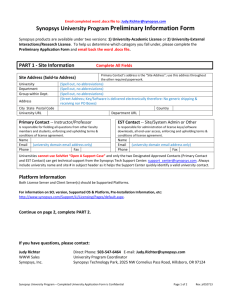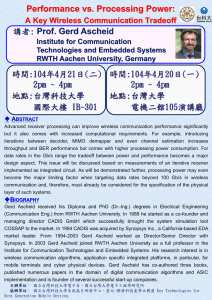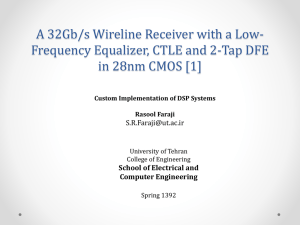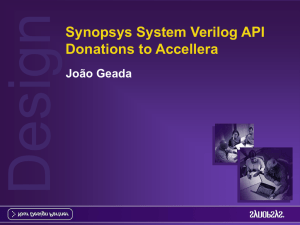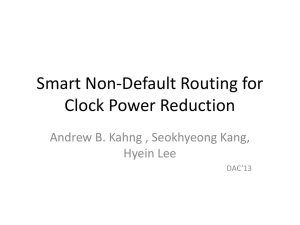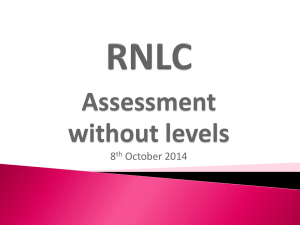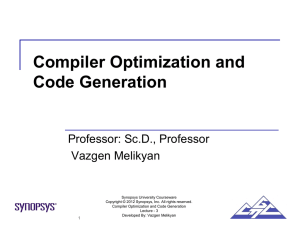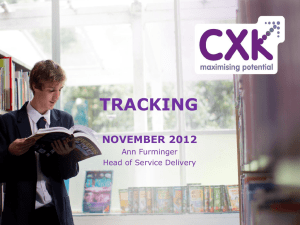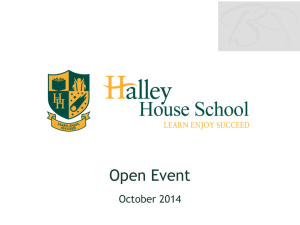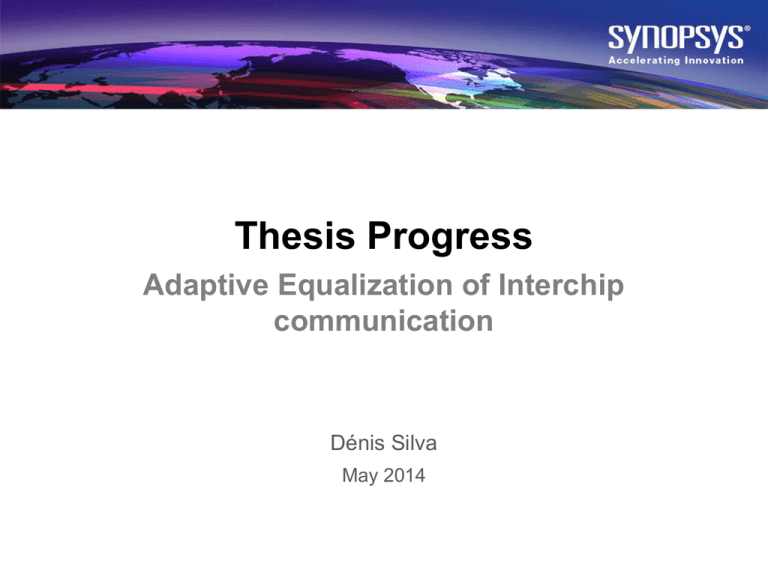
Thesis Progress
Adaptive Equalization of Interchip
communication
Dénis Silva
May 2014
© 2014 Synopsys. All rights reserved.
1
MIPI physical Layer
© 2014 Synopsys. All rights reserved.
2
Contents
• This presentation demonstrates some results for the
adaptation of the CTLE and DFE for the MPhy reference
channels
– Results for the CTLE adaptation using Assynchronous undersampling-histograms
– Results for the adaptation of the DFE using the LMS algorithm
© 2014 Synopsys. All rights reserved.
3
Channel characterization
Reference channels and package models represented in S-Parameters
© 2014 Synopsys. All rights reserved.
4
Reference channel1
© 2014 Synopsys. All rights reserved.
5
Reference channel 2
© 2014 Synopsys. All rights reserved.
6
Eye Openign Diagrams
Tested eye opening diagrams for both Reference channels.
Simulation Parameters:
1. HS_G1_A :1.248 Gbits/s
Vdiff=2V
2. HS_G2_B : 2.915Gbits/s
Trise=Tfall=0.1UI
3. HS_G3_B :5.8304Gbs/s
Maximum length PRBS
with 8 Taps
4. HS_G4_B :11.66Gbs/s
© 2014 Synopsys. All rights reserved.
7
Simulation Settings
© 2014 Synopsys. All rights reserved.
8
Eye Opening Diagrams Ref1
© 2014 Synopsys. All rights reserved.
9
Eye Opening Diagrams Ref2
© 2014 Synopsys. All rights reserved.
10
CTLE optimizer settings
The CTLE consists in a one zero , Two pole Transfer Function.
Optimize CTLE poles and zeros for maximum eye opening
• 1000bits/eye diagram calculation
• Bit by bit simulation Mode
• Random Optimizer
• Maximize Eye Width and Height.
© 2014 Synopsys. All rights reserved.
11
CTLE optimizer results Ref1 HS_G1_A
*Contains a correction to bring DC gain to 0dBc
© 2014 Synopsys. All rights reserved.
12
CTLE optimizer results Ref1 HS_G2_B
*Contains a correction to bring DC gain to 0dBc
© 2014 Synopsys. All rights reserved.
13
CTLE optimizer results Ref1 HS_G3_B
*Contains a correction to bring DC gain to 0dBc
© 2014 Synopsys. All rights reserved.
14
CTLE optimizer results Ref1 HS_G4_B
*Contains a correction to bring DC gain to 0dB
© 2014 Synopsys. All rights reserved.
15
CTLE optimizer results Ref2 HS_G1_A
*Contains a correction to bring DC gain to 0dB
© 2014 Synopsys. All rights reserved.
16
CTLE optimizer results Ref2 HS_G2_B
*Contains a correction to bring DC gain to 0dB
© 2014 Synopsys. All rights reserved.
17
CTLE optimizer results Ref2 HS_G3_B
*Contains a correction to bring DC gain to 0dB
© 2014 Synopsys. All rights reserved.
18
CTLE optimizer results Ref2 HS_G4_B
© 2014 Synopsys. All rights reserved.
19
CTLE results
© 2014 Synopsys. All rights reserved.
20
CTLE results
Position of the zero and the two poles of the CTLE
Gear
Ghz
Ref.Channel1
Z
P1
HS_G1_A
0.275
0.425 4.473
set1
0.851 2.011 3.833
set5
HS_G2_B
0.234
0.435 3.253
set2
0.880 1.974 3.823
set6
HS_G3_B
1.873
5.775 5.679
set3
1.365 3.189 9.317
set7
HS_G4_B
3.262
8.639 11.37
set4
1.193 5.659 12.85
set8
© 2014 Synopsys. All rights reserved.
21
Ref.Channel2
Z
P1
P2
P2
CTLE adaptation
The CTLE will be adapted with assynchronous undersampling histograms(the bigger peak in the received
sample histogram results in the biggest eye opening).
• The tests were made for reference channel 1
• Bit Rate of 11.66Gbits/s
• Bit by bit channel Simulation
• 3K bits Prbs9 sequence transmited
• Over-sampling factor :16
• To construct the histogram samples were selected in a
time step (23/16)*UI
© 2014 Synopsys. All rights reserved.
22
Eye vs histograms
© 2014 Synopsys. All rights reserved.
23
Eye vs histograms
© 2014 Synopsys. All rights reserved.
24
Eye vs histograms
Before
CTLE
Set1
Set2
Set3
Set4
Level0
0.685
0.566
0.837
0.988
0.886
Level1
-0.685
-0.566
-0.837
-0.988
-0.886
Height
0.718
0
0.331
1.285
1.255
Width
56.10ps
13.72ps
38.59ps
59.18ps
63.8ps
JitterPP
29.59ps
69.86ps
46.81ps
26.5ps
21.87ps
JitterRms
6.846ps
13.97ps
9.361ps
6.204ps
6.046ps
259
221
347
482
Hist_peak 448
Selected_Setting
© 2014 Synopsys. All rights reserved.
25
LMS Algorithm
• The Lms algorithm tries to minimize the quadratic error
e(n).
𝑐𝑘 + 1 = 𝑐𝑘 − 𝜇 ∗ 𝑒𝑛 ∗ 𝑦𝑛
• The error signal en can be calculated in training mode or
in blind Mode(decision Direct).
© 2014 Synopsys. All rights reserved.
26
LMS ALgorithm
Training mode
In the absence of errors Training mode takes a lot to
converge
Consider for the error expression the input of the decision
element:
𝑒𝑛 = dn − xn
Blind Mode
Blind mode has problems of converge if the number of wrong decisions is
above a certain threshhold (typically >1%)
© 2014 Synopsys. All rights reserved.
27
LMS Algorithm
• The simulation was made with 5000 bits Generated by a
maximum length PRBS generator.
• 1sample/bit Vin=+-1
• Noise variance =0.001
• Number of DFE taps=4
• Decision Direct mode
© 2014 Synopsys. All rights reserved.
28
LMS Algorithm
© 2014 Synopsys. All rights reserved.
29
LMS Algorithm
Influence of the step size in DFE convergence speed
© 2014 Synopsys. All rights reserved.
30
Spice modeling of the communication
channel
• Due to some problems with convergence in the ADS
simulations continued in Hspice
• Verilog A models were developed for the
Receiver,CTLE,DFE,Data Slicers and the assynchronous
Undersampling calculator block.
• The Channel was described using a subcircuit in Hpice.
© 2014 Synopsys. All rights reserved.
31
Spice modeling of the channels Ref1
S13 represents the insertion loss of pk1+ref_channel1+pk2
© 2014 Synopsys. All rights reserved.
32
Spice modeling of the channels Ref2
S13 represents the insertion loss of pk1+ref_channel2+pk2
© 2014 Synopsys. All rights reserved.
33
Spice simulations
1. Impulse response of both channels
2. Distortion introduced by the channels
3. Study of the CTLE
1. Ac simulation of the CTLE
2. Transient simulation of the efects of the CTLE in the bit
sequence.
3. Transient simulation for the assynchronous histogram model
4. Convergence of The LMS algorithm with the use of
diferent training sequences
1. Simulation of Blind and Training equalization Methods
5. Error correction for the 1,2 and 3 tap DFE
© 2014 Synopsys. All rights reserved.
34
1-Spice simulation of the channels
impulse response
© 2014 Synopsys. All rights reserved.
35
Reference channel1/2
Ref.Channel1
Group Delay
Ref.Channel1
2.935ns
1.273ns
Main Tap atenuation
~25%(1.512/2)
~55%(0.965/2)
1st post tap ISI
0.22/1.5~0.14
0.21/0.965~0.21
2nd post tap ISI
0.1/1.5~0.066
0.1658/0.965~0.16
3rd post tap ISI
0.05/1.5~0.033
0.05/0.965~0.05
*Results obtained with spice command Measure.
© 2014 Synopsys. All rights reserved.
36
2-Reference channel1/2 Distortion
Critical decisions
© 2014 Synopsys. All rights reserved.
37
3.1.CTLE AC simulations in Spice
The frequency response of the verilog A CTLE model closely matchs the
optimal value calculated in ADS
© 2014 Synopsys. All rights reserved.
38
3. CTLE /histogram transient simulation
Specifics of the simulation
• bitRate=11.66 Gb/s
• Reference Channel1
• Assynchronous clock = 2.3 slower than bitRate
• Number of samples for histogram calculation=400
• Time required for histogram calculation=
Nsamples*clockPeriod ~59ns
• Time required for CTLE adaptation=
Nsamples*clockPeriod*NumberOfSettings
© 2014 Synopsys. All rights reserved.
39
3.2 CTLE transient simulation
Over-equalization
© 2014 Synopsys. All rights reserved.
40
3.2 Histogram transient analysis
Selected setting
© 2014 Synopsys. All rights reserved.
41
3.2 Histogram transient analysis
Variation of the histogram with the number of samples
© 2014 Synopsys. All rights reserved.
42
DFE convergence reference channel1
Blind adaptation behaves the same way as training mode in the absence of
decision errors.
The reference channel 2 introduces bit errors if the sequence of 1’s or 0’s is
bigger than 4bits
In the absence of Noise a simple slicer would correctly recover the sent sequence
in ref_channel1
Ref.Channel1
Group Delay
Ref.Channel2
1.273ns
2.935ns
Main Tap atenuation
~25%(1.512/2)
~55%(0.965/2)
1st post tap ISI
0.22/1.5~0.14
0.21/0.965~0.21
2nd post tap ISI
0.1/1.5~0.066
0.1658/0.965~0.16
3rd post tap ISI
0.05/1.5~0.033
0.05/0.965~0.05
© 2014 Synopsys. All rights reserved.
43
DFE training Paterns
© 2014 Synopsys. All rights reserved.
44
DFE blind convergence ref_channel2
Only PRBS converges to the correct value of the taps
© 2014 Synopsys. All rights reserved.
45
4 .DFE convergence channel ref1
Step=0.0025
© 2014 Synopsys. All rights reserved.
46
4.DFE convergence channel ref2
Step size=0.0025
© 2014 Synopsys. All rights reserved.
47
DFE Simulations step size Prbs9
Tap evolution for step sizes = 0.0025 0.005 0.0075 0.01 0.0125
Reference_channel1
© 2014 Synopsys. All rights reserved.
48
DFE Simulations sample jitter Prbs9
Simulation for jitter in the sample time = 'UI/10' 'UI/7.5' 'UI/5' 'UI/4‘
Reference_channel1
© 2014 Synopsys. All rights reserved.
49
DFE Simulations Noise Simulations
(training)
Vin=+-160mv | reference channel2 |11.66Gb/s
© 2014 Synopsys. All rights reserved.
50
DFE Simulations Noise Simulations
(training mode)
Vin=+-160mv | reference channel2 |11.66Gb/s
© 2014 Synopsys. All rights reserved.
51
DFE Simulations Noise Simulations
(blind mode)
• Vin=+-160mv | reference channel2 |11.66Gb/s
© 2014 Synopsys. All rights reserved.
52
5.DFE Simulations Error correction
• To increase the ammount of errrors caused by the
channel, introduced a second channel in series with the
first one
• Comparison between the errors correction of an ideal
slicer and a 1,2 or 3 tap DFE.
© 2014 Synopsys. All rights reserved.
53
5.1DFE Simulations Error correction
© 2014 Synopsys. All rights reserved.
54
Conclusion
• Use PRBS9 for the training sequence
• In the absence of errors training mode and blind mode
converge for the same values
• The assynchronous under-sampling technique with a
small number of samples is capable of making correct
decision on the CTLE settings
• The LMS shows good convergence characteristics even
in the presence of jitter in the sample time.
• To make more precise mearuments for the time required
for adaptation some standarts must be defined.
© 2014 Synopsys. All rights reserved.
55
Future Work ?
Test full system system with CTLE DFE and histogram.
1. Test circuit implementations for the CTLE
2. Simulate physical implementations of the DFE
3. Study the possibility of FIR Rx transversal equalizer
4. Study Tx FIR equalization and possible adaptation
5. Noise and Jitter measuremnts in training sequences
6. Simulate non ideal behaviour of the components of the
system such as the slicers,CTLE ,DFE.
7. Implementation of the controller
© 2014 Synopsys. All rights reserved.
56

